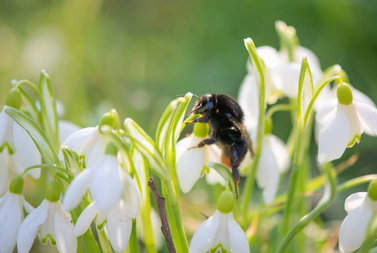Study of nectar production in European forests brings good and bad news for wild pollinators
(19-03-2024) A new study by the Forest & Nature Lab (ForNaLab) of the Faculty of Bioscience Engineering (UGent) brings bad news: the availability of nectar in the herb layer of European forests has decreased by a quarter over the last forty years.
Spring is in the air, and we welcome back all sorts of wild pollinators, such as wild bees, bumblebees, and hoverflies. They are very important for our food production but are struggling. Until now, forests have barely been considered in studies on habitats for wild pollinators. Especially the role of the herb layer (all plants less than one meter tall) was greatly underexplored. The study 'Declining potential nectar production of the herb layer in temperate forests under global change' in the Journal of Ecology changes this.
"Up to 25 percent less nectar in the herb layer of European forests" - Wim De Schuyter
The authors calculated for more than 3,300 forest patches across Europe the amount of nectar that the herb layer there could potentially provide. They used data on the plant composition of these patches at different times over the last forty years and combined it with information on the typical nectar production of those plants. From this, they cannot derive actual, real nectar production – for that, data on the proportion of plants that actually bloom at the concerned location is missing – but it does become possible to compare between different places and times. Main findings:
An average decrease of nearly 25% in potential nectar production over the last 40 years has been observed, largely due to darker forest conditions caused by less intensive forest management in the studied forests.
The herb layer in forests appears to be a potentially important source of nectar, especially in spring before the canopy closes. The availability of nectar is comparable to that of other habitats, such as species-rich grasslands, but with an earlier peak, which could be crucial for, for example, early-emerging bumblebee queens.
Further research is needed to fully understand the role forests can play as habitats for wild pollinators, say the scientists, including into actual nectar production and how the different layers in the forest (herb layer, shrub layer, tree layer) perform together. Nevertheless, this study makes it clear that forests have the potential to play an important role in preserving wild pollinators.
The authors therefore emphasize the need for more and larger forests, where diverse management strategies are applied. This way, attractive zones for pollinators can be created as well as zones with a cool, well-buffered microclimate in which typical forest species can thrive.
"The threat to wild pollinators is potentially a problem for our food production and the preservation of general biodiversity. I hope that this research will also contribute to future policy in support of wild pollinators." - Wim De Schuyter
About the researchers
The research was conducted by a team from the ForNaLab of Ghent University, led by Wim De Schuyter, Pieter De Frenne, Emiel De Lombaerde, Leen Depauw, Pallieter De Smedt, Lander Baeten, and Kris Verheyen.
For more information and access to the full study, visit ForNaLab and forestREplot.
Photo credits: Robin Bosteels
Contact:
Wim De Schuyter
PhD Student
+32 (0)472 48 43 26
Professor Kris Verheyen
ForNaLab (UGent)
+32 (0)472 36 22 69
Maarten De Coninck
Communication Officer Faculty of Bioscience Engineering
+3247035446
